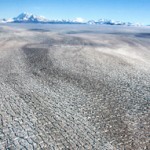Gaseous dinosaurs and surging glaciers
January 12, 2011
907-474-7468
January 12, 2011
SAN FRANCISCO - The emissions of northern dinosaurs may have led to a warmer planet 70 million years ago, said a scientist attending the 2010 American Geophysical Union Fall Meeting in mid-December. Dinosaur hunters have found preserved footprints of hadrosaurs in rocks all over Alaska, including: Denali National Park, near the Colville River north of the Brooks Range, at Aniakchak National Monument and Preserve on the Alaska Peninsula, and in Yukon-Charley National Park and Preserve.
Tony Fiorillo of the Museum of Nature and Science in Dallas, Texas started thinking about all those hadrosaurs being plant-eating dinosaurs as large as elephants and their nickname, bestowed by paleontologists: cows of the Cretaceous. At AGU, Fiorillo presented his idea that hadrosaurs were spread across the landscape at numbers comparable to today's caribou, a calculated "standing crop" of 500,000 hadrosaurs in Alaska 70 million years ago.
He figured the output of one hadrosaur equaled that of about 10 cows, and then he extrapolated. Because there are published reports on how much methane wafts from the average cow pie, Fiorillo figured that the Alaska hadrosaurs might have contributed an impressive amount of the greenhouse gas to the atmosphere. In short, "hadrosaurs may have contributed to a warmer Arctic," he said.
The world of the hadrosaurs might also have featured wildfire behavior similar to what we see in the north today, Fiorillo said. The Alaska climate experienced by dinosaurs was probably comparable to current trends in the region between Portland, Oregon and Calgary in Alberta, Canada. "It must have been delightful," he said. "Lush vegetation and high mountains in the distance." Winter was perhaps the dry season 70 million years ago, which may have made spring the fire season.
Fiorillo and other scientists have found charcoal embedded in some fossil sites. He thinks fires and dinosaurs may have been responsible for the open landscape upon which the dinosaurs apparently lived. "Fire might have made clearings, and (plant-eating dinosaurs) maintained them, something like giraffes and hippos do today," he said.
more about Arctic dinosaurs, their environment and a look at the research behind these discoveries in this episode of the PBS series NOVA
* * *

"The surge front has hit the terminus and has shattered where the glacier enters Vitus Lake," said Chris Larsen, a glaciologist with the University of Alaska Fairbanks' Geophysical Institute. When a glacier like Bering or Black Rapids surges, it is usually not growing. Instead, a section has suddenly started moving.
In the case of Bering, the glacier had gained elevation miles upstream of where it calves icebergs into Vitus Lake. But the glacier for some reason did not surge at its lowest point until recently. Next to his poster displayed at the AGU meeting, U.S. Geological Survey glaciologist Bruce Molnia tacked up an image of Bering, Alaska's largest glacier, taken on Nov. 19, 2010.
The image showed the thrust of the glacier into Vitus Lake. Molnia had last been at the glacier in August, when the surge was still limited to the upper portion of the glacier. "Sometime after Aug. 10, the surge started to be transferred (to the tongue)," Molnia said.
Much more about the results of glacier research performed at UAF in this 1 hour 28 minute colloquium from the U.S. Department of Commerce National Institute of Standards and Technology posted in August 2010.
This column is provided as a public service by the Geophysical Institute, University of Alaska Fairbanks, in cooperation with the UAF research community. Ned Rozell is a science writer at the institute.


